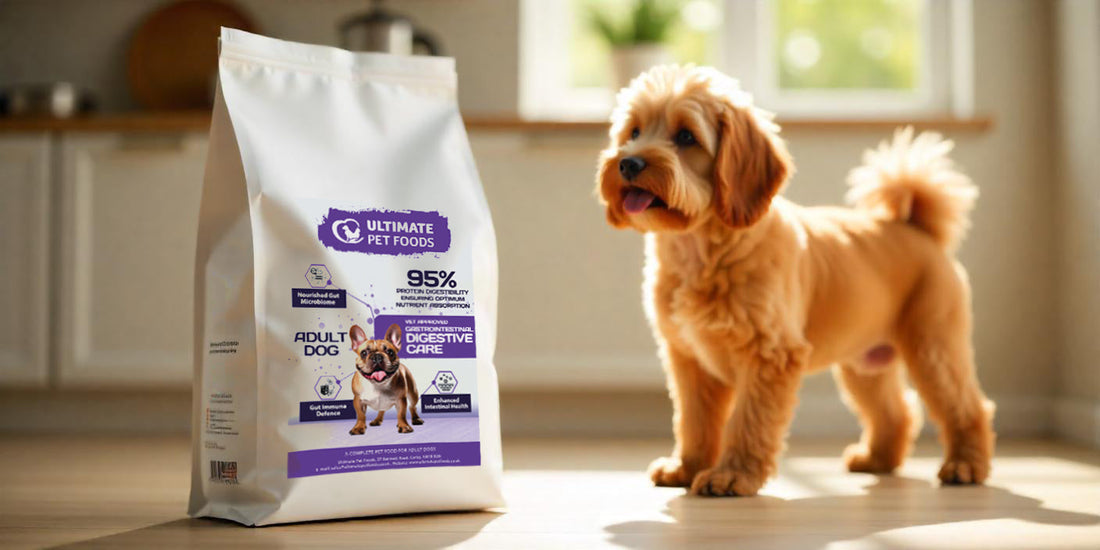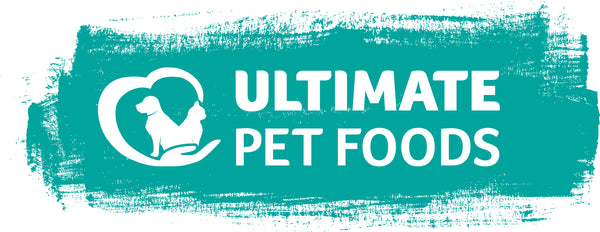
Why Upgrading Your Supermarket Brand Dog Food May Be the Best Decision You Make in 2025
Share
Introduction
As we navigate through 2025, many of us are looking for meaningful ways to improve our lives and the lives of those we care about. Whilst we often focus on personal health goals, career advancements, or home improvements, there's one decision that could dramatically impact a beloved member of your household—your dog. Upgrading from standard supermarket brand dog food to a higher quality option might seem like a small change, but it could be the most significant improvement you make this year for your four-legged companion's health, happiness, and longevity.
The Current State of the Dog Food Industry
The dog food industry has undergone remarkable transformation in recent years. What was once a market dominated by a handful of major brands offering similar products has evolved into a diverse ecosystem of options ranging from budget-friendly supermarket brands to premium, speciality, and even customised nutrition plans.
This evolution reflects our changing relationship with pets. Dogs have transitioned from being merely household animals to beloved family members deserving of the same health considerations we give ourselves. According to industry reports, premium and natural dog food segments have seen double-digit growth annually, whilst traditional economy options have stagnated.
Despite this shift, many dog owners still reach for familiar supermarket brands out of habit, convenience, or perceived value. However, a closer look at what's actually in these products might give you pause.
Why Upgrading Your Supermarket Brand Dog Food May Be the Best Decision
Standard supermarket dog foods often prioritise cost-efficiency over nutritional quality. Many contain fillers like corn, wheat, and soy that provide calories but limited nutritional value for dogs, who are primarily carnivorous. These products may also contain artificial preservatives, colours, and flavours that serve no nutritional purpose.
The truth is that many budget-friendly dog foods meet only minimum nutritional requirements—they keep your dog alive but don't necessarily help them thrive. They often contain meat by-products rather than whole meat sources and may include ingredients that dogs commonly develop sensitivities to over time.
By upgrading your dog's food in 2025, you're not just changing their diet—you're potentially reshaping their health trajectory for years to come. As new research continues to highlight the connection between diet and canine health, making this switch now puts you ahead of the curve.
Benefits of Upgrading Dog Food
Switching to higher quality dog food offers numerous advantages:
Improved Ingredient Quality: Better dog foods typically feature whole-source proteins as their primary ingredients rather than meat by-products or fillers. They often include real fruits and vegetables that provide natural sources of essential vitamins and minerals.
Enhanced Digestibility: Premium foods are typically more digestible, meaning your dog's body can actually utilise more of what they eat. This leads to smaller, less odorous stools—a benefit any dog owner can appreciate.
Fewer Artificial Additives: Quality dog foods minimise or eliminate artificial colours, flavours, and preservatives, reducing potential allergens and irritants.
Appropriate Nutritional Balance: Higher-tier dog foods are formulated with more precise nutritional profiles based on current veterinary science rather than just meeting minimum standards.
Breed and Life-Stage Specific Options: Many upgraded food lines offer formulations tailored to specific breeds, sizes, or life stages, addressing your dog's unique nutritional needs.
The Impact on Your Dog's Health
The food your dog consumes directly impacts nearly every aspect of their health:
Skin and Coat Health: One of the first visible improvements after upgrading dog food is often a shinier coat and reduced skin issues. Essential fatty acids found in quality proteins and added supplements like fish oil support skin health and reduce itching and flaking.
Energy Levels: Many dog owners report noticeably increased vitality and playfulness after switching to better food. This comes from improved metabolic function and better nutrient absorption.
Digestive Health: Premium foods with high-quality ingredients typically cause fewer digestive issues. The inclusion of prebiotics and probiotics in many upgraded foods supports gut health, potentially reducing gas, bloating, and irregular bowel movements.
Weight Management: Higher quality foods often help maintain appropriate weight more effectively. They're typically more nutrient-dense but less calorie-dense than foods filled with carbohydrate fillers.
Long-term Health Outcomes: Perhaps most importantly, improved nutrition can contribute to longer, healthier lives with reduced incidence of chronic conditions like diabetes, obesity, and certain types of cancer that have been linked to poor diet.
Cost-effectiveness of Upgrading Dog Food
The sticker price of premium dog food can cause initial sticker shock. A bag of high-quality dog food might cost 50-100% more than economy brands. However, this surface-level comparison doesn't tell the whole story.
Consider these factors:
Feeding Efficiency: Because premium foods contain more digestible ingredients and fewer fillers, dogs typically need to eat less volume to meet their nutritional needs. A bag of premium food often lasts longer than you might expect.
Reduced Veterinary Costs: Many chronic health issues that require expensive veterinary care are directly related to nutrition. Investing in preventative health through better food can save substantial money on treatments for conditions that might have been avoided.
Fewer Supplements Needed: Many premium foods already include supplements like omega fatty acids, glucosamine, and probiotics that you might otherwise purchase separately.
Quality of Life Value: Whilst harder to quantify, the value of having a happier, more energetic, and comfortable dog adds immeasurable worth to your investment.
When calculated over your dog's lifetime, the apparent premium you pay for better food often balances out or even results in savings, particularly when accounting for potential reduction in healthcare costs.
How to Choose the Best Upgraded Dog Food for Your Dog
Upgrading doesn't necessarily mean buying the most expensive option. It means making a thoughtful choice based on your dog's specific needs:
Read Ingredient Lists: Look for foods where whole-source proteins (like chicken, beef, fish) are listed as the first ingredients rather than meat by-products or grains. Avoid foods with artificial colours, flavours, or preservatives.
Consider Your Dog's Specific Needs: Age, size, breed, activity level, and any existing health conditions should influence your choice. Many brands offer specialised formulations for puppies, seniors, large breeds, or dogs with sensitivities.
Look for Quality Standards: Check that the food meets recognised nutritional standards for pet food. In the UK, look for foods that comply with FEDIAF (European Pet Food Industry Federation) guidelines.
Consult Your Veterinarian: Your vet can provide personalised recommendations based on your dog's health history and needs. They may suggest specific brands or formulations appropriate for any conditions your dog has.
Transition Gradually: When upgrading food, mix increasing amounts of the new food with decreasing amounts of the old over 7-10 days to prevent digestive upset.
Monitor Your Dog's Response: After switching, watch for improvements in energy, coat quality, and stool consistency. These are good indicators that the new food is working well for your dog.
Try Our FREE Grain-Free Sample Box
Ready to see the difference premium nutrition can make for your dog? We're so confident in the quality of our grain-free dog food that we're offering FREE sample boxes for a limited time.
Our grain-free recipes feature:
- High-quality, ethically-sourced animal proteins as the first ingredient
- No artificial colours, flavours, or preservatives
- Nutrient-rich fruits and vegetables
- Added prebiotics for digestive health
- Omega-3 and omega-6 fatty acids for skin and coat health
Simply visit our website to claim your FREE sample box today. Your dog deserves to experience the difference that proper nutrition can make!
Conclusion
As we move through 2025, the simple act of upgrading your dog's food from standard supermarket brands to higher quality options represents one of the most impactful changes you can make for their wellbeing. This single decision influences every aspect of your dog's health, from daily energy levels to long-term disease prevention.
Whilst the upfront cost may be higher, the potential benefits—reduced veterinary bills, fewer supplements needed, and most importantly, a happier, healthier companion—make this one of the most worthwhile investments you can make this year.
When considering a switch, it's essential to transition gradually to avoid digestive upset. Start by mixing a small amount of the new food with the current one, gradually increasing the proportion over a week. nhaf.org
Your dog gives you unconditional love and loyalty every day. Providing them with the best possible nutrition is a tangible way to return that devotion. In the years to come, as you enjoy the company of a vibrant, healthy pet, you'll likely look back on the decision to upgrade their food as one of the best choices you made in 2025.
Remember: you are your dog's only advocate when it comes to their nutrition. They can't read labels or make informed choices—that responsibility falls to you. Make it count by trying our FREE grain-free sample box today!
